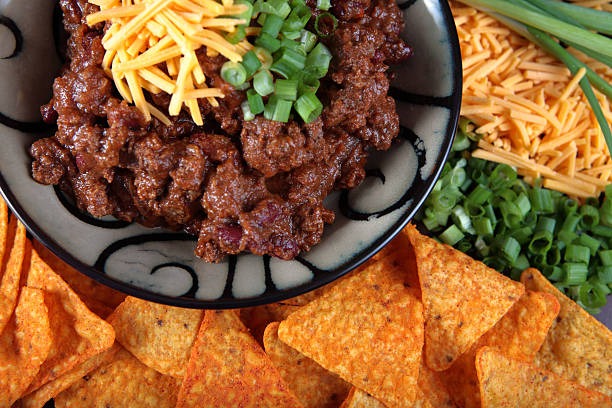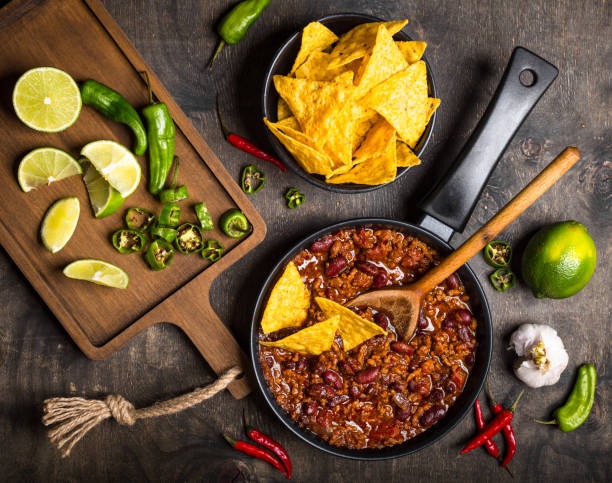I still remember the first time I scooped up a steaming bowl of Texas chili at a dusty rodeo in West Texas. The air was thick with the scent of mesquite smoke and sizzling beef, and that first bite hit me like a bolt of lightning—rich, spicy, and unapologetically bold. No beans in sight, just pure meaty goodness wrapped in a sauce that sang of chiles and history. That moment hooked me for life, turning a simple stew into a passion. If you’re new to this iconic dish or just craving a deeper dive, stick with me as we uncover the soul of Texas chili, from its rugged origins to the perfect pot you can make at home.
What Exactly Is Texas Chili?
Texas chili, often called a “bowl of red,” is a hearty stew that’s all about beef, chiles, and spice—no fillers, no fuss. It’s the kind of dish that warms you from the inside out, born from the harsh landscapes of the Lone Star State where cowboys needed something sustaining yet simple. Unlike bean-heavy versions from other regions, authentic Texas chili keeps it pure, letting the flavors of slow-cooked meat and roasted peppers shine through.
This simplicity is what sets it apart, making every spoonful a testament to tradition. I’ve shared bowls of it with friends around campfires, watching their eyes light up as the heat builds—just enough to make you reach for a cold beer without overwhelming the palate.
Why No Beans in Texas Chili?
The no-bean rule in Texas chili is practically sacred, a line in the sand that separates true Lone Star lovers from the rest. Beans were seen as a cheap filler back in the day, something chuckwagon cooks avoided to keep the focus on premium beef. Today, it’s a point of pride; add beans, and you’ve crossed into “chili con carne with extras” territory, which some folks say dilutes the bold essence.
I once made the mistake of tossing in kidney beans during a family cook-off—my uncle shot me a look that could curdle milk, then good-naturedly schooled me on the classics. It’s all in good fun, but it underscores how deeply this tradition runs in Texas culture.
The Bean Debate: Pros and Cons
- Pros of No Beans: Keeps the dish meat-forward, allowing chiles and spices to dominate; easier on digestion for some; stays true to historical recipes.
- Cons of No Beans: Might feel less filling for big appetites; requires more beef, upping the cost.
On the flip side, if you do add beans:
- Pros: Boosts fiber and volume; makes it stretch further for crowds; appeals to vegetarian adaptations.
- Cons: Alters the texture and authenticity; can make the chili mushier over time.
The Rich History of Texas Chili
Texas chili’s story starts long before statehood, weaving through Mexican roots and frontier grit into a dish that defines the American Southwest. It evolved from simple stews of dried beef and chiles carried by vaqueros, transforming into the beefy staple we know today. By the late 1800s, it had captured hearts across the plains, fueled by the ingenuity of everyday folks turning limited ingredients into flavor gold.
What I love most is how this history feels alive in every pot—it’s not just food; it’s a narrative of resilience. Picture dusty trails and open fires; that’s the vibe that still lingers in a well-made batch.
Origins in Mexico and the Texas Frontier
Chili con carne traces back to ancient Mesoamerican stews spiced with native chiles, but it took on its Texas twist in the 19th century. Spanish-introduced cattle met indigenous peppers, creating carne con chile that ranch hands adapted for long cattle drives. No refrigeration meant dried meats and bold seasonings were key, birthing the no-frills style that stuck.
Historians point to northern Mexico’s influence, where tasajo—salted dried beef—was stewed with chiles. As Texans borrowed and refined it, the dish became a symbol of independence, much like the state itself.
The Legendary Chili Queens of San Antonio
In the 1860s, San Antonio’s Chili Queens turned street carts into culinary legends, serving steaming pots under lantern light in Military Plaza. These Tejana women dished out affordable bowls to laborers and soldiers, blending Mexican flavors with local beef to create an irresistible draw. Their chili—fiery, fragrant, and always bean-free—drew crowds until health regulations shut them down in the 1940s.
I visited the plaza years ago, imagining the sizzle and chatter; it’s a reminder of how women shaped Texas foodways. For more on their story, check out this Texas Monthly article.
Becoming the Official State Dish
In 1977, the Texas Legislature crowned chili con carne the official state dish, a nod to its cultural bedrock. Sponsored by Rep. Ben Z. Grant, the resolution celebrated its role in Texan identity, from chuckwagons to chili cook-offs. Today, it graces fairs, festivals, and family tables statewide.
This honor feels right—chili embodies Texas’s big, bold spirit. It’s why events like the Terlingua International Chili Championship draw thousands, turning rivalry into ritual.
Essential Ingredients for Authentic Texas Chili
At its core, Texas chili relies on high-quality beef and a symphony of dried chiles for depth—no canned sauces or shortcuts here. Chuck roast or brisket provides the tender bite, while spices like cumin and oregano add earthy warmth. The magic happens in the chile paste, blending varieties for layers of smoke, fruit, and fire.
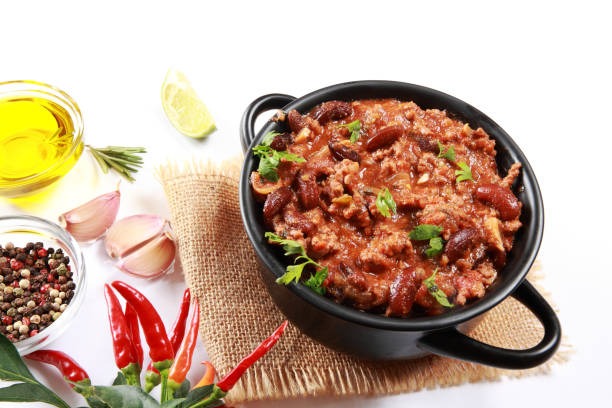
I’ve experimented with different chiles over the years, and nothing beats toasting them fresh; it releases aromas that fill the kitchen like a hug from an old friend. Keep portions simple to let these stars shine.
The Star: Dried Chiles and Their Roles
Dried chiles are the soul of Texas chili, offering complexity that powder alone can’t match. Anchos bring mild sweetness and raisin notes, guajillos add tang and earthiness, while arbols kick in the heat. Soak, blend, and simmer them into a paste for that signature red hue.
Sourcing tip: Hit up a Latin market for the best selection—fresher means brighter flavors. Avoid over-toasting; burnt chiles turn bitter fast.
| Chile Type | Flavor Profile | Heat Level (Scoville) | Amount in Recipe (for 4 lbs beef) |
|---|---|---|---|
| Ancho | Sweet, fruity, mild | 1,000-2,000 | 6 pods |
| Guajillo | Earthy, tangy | 2,500-5,000 | 2-4 pods |
| Pasilla | Rich, berry-like | 1,000-2,500 | 2 pods |
| Arbol | Sharp, nutty | 15,000-30,000 | 2-4 pods (for heat) |
Beef and Aromatics: Building the Base
Chuck roast, cut into 1/2-inch cubes, is ideal for its marbling that melts into juicy tenderness after hours of simmering. Onions, garlic, and jalapeños form the aromatic backbone, sautéed to release sweetness without overpowering the chiles.
Pro tip: Trim excess fat but leave some for richness. Ground beef works in a pinch but lacks the texture of cubes—think of it as fast food vs. fine dining.
Spices and Secret Add-Ins
Cumin, oregano, and a pinch of cinnamon elevate the profile, drawing from Mexican influences. Some swear by coffee or dark chocolate for subtle bitterness that balances the heat. Masa harina thickens without dulling flavors.
Humor alert: Skip the sugar unless your chiles are extra fiery—I’ve overseetened pots and ended up with dessert chili, which, surprisingly, wasn’t half bad with ice cream!
Step-by-Step Guide to Making Authentic Texas Chili
Crafting Texas chili is a labor of love, rewarding patience with layers of flavor that build over hours. Start with prepping your chiles and beef, then layer everything in a Dutch oven for slow simmering. The key? Low heat and occasional stirs to meld it all into perfection.
My go-to method comes from family tweaks on old recipes—it’s forgiving for beginners but shines with practice. Expect 3-4 hours total, plus resting time for even better taste tomorrow.
Prep Your Chiles: The Foundation
Toast dried chiles in a dry skillet over medium heat for 1-2 minutes per side until fragrant, then soak in hot water for 20-30 minutes. Stem, seed, and blend with a bit of soaking liquid, garlic, and salt into a smooth paste. This step unlocks their full potential, creating the red gravy that defines the dish.
Don’t rush the soak; under-hydrated chiles lead to gritty bits. Strain if needed for silkiness.
Brown the Beef and Build Layers
Cube 4 pounds of chuck roast, season with salt, pepper, and cumin, then brown in batches in hot oil or bacon fat in a large pot. Remove beef, sauté diced onion, garlic, and fresh peppers until softened—about 5 minutes. Return beef, add chile paste, and cook 2-3 minutes to bloom flavors.
Browning is non-negotiable; it creates fond that deepens the broth. I’ve skipped it once—bland results taught me quick.
Simmer to Perfection
Deglaze with beer or beef stock, add water to cover, plus brown sugar, Worcestershire, and spices. Bring to a boil, then simmer covered on low for 2-3 hours until beef shreds easily. Thicken with masa harina slurry in the last 30 minutes.
Taste hourly—adjust salt or heat as it reduces. For crockpot fans, low for 6-8 hours works wonders.
Full Ingredient List and Yields
Here’s what you’ll need for 8-10 servings:
- 4 lbs chuck roast, cubed
- 6 ancho chiles, 2 guajillo, 2 pasilla, 4 arbol
- 1 large onion, 4 garlic cloves, 2 jalapeños
- 2 tsp cumin, 1 tsp oregano, 1/2 tsp cinnamon
- 2 cups beef broth, 1 bottle beer, 2 cups water
- 2 tbsp masa harina, 1 tbsp brown sugar
- Salt, pepper to taste
Yields about 12 cups; stores in fridge for 4 days or freezes for months.
Variations on the Classic Texas Chili
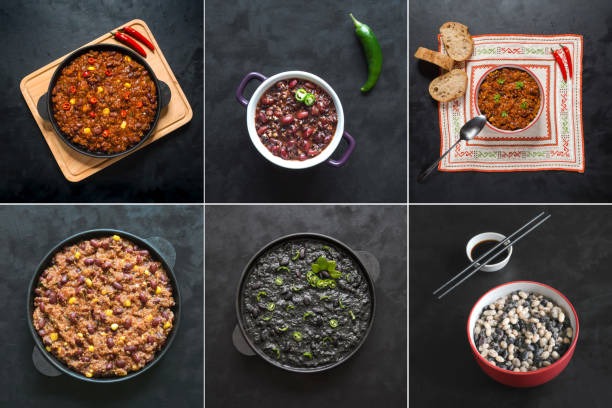
While purists stick to the basics, Texas chili invites tweaks for spice levels or dietary needs without losing its soul. Swap beef for venison in hunting season, or go milder with fewer arbols for family gatherings. These changes keep it versatile yet rooted.
I once tried a venison version after a hunting trip—gamier, but the chiles tamed it beautifully. Experimentation is half the fun, as long as beans stay out!
Regional Twists Across Texas
East Texas might lean sweeter with more onions, while West Texas amps the heat with extra serranos. San Antonio honors the queens with tomato-free purity, but Austin adds a hipster edge like smoked paprika.
Comparisons show how geography shapes taste—think fiery border styles vs. milder panhandle takes.
| Region | Key Twist | Heat Level | Signature Add-In |
|---|---|---|---|
| San Antonio | Pure chile paste focus | Medium | Chipotle for smoke |
| West Texas | Extra fresh peppers | High | Cayenne boost |
| East Texas | Sweeter, onion-heavy | Mild | Brown sugar |
| Austin | Modern spices | Variable | Smoked elements |
Modern Adaptations: Ground Beef or Slow Cooker
For quicker meals, ground beef simmers in 1 hour, retaining flavor if you toast spices first. Slow cookers mimic chuckwagon ease, set-and-forget for 8 hours.
Pros of ground beef: Faster, uniform texture. Cons: Less chew, can get greasy.
Slow cooker pros: Hands-off. Cons: Harder to brown properly upfront.
Where to Find the Best Texas Chili in the Lone Star State
Hunting down top-notch Texas chili means road-tripping to spots where tradition meets expertise. From hole-in-the-wall joints to championship winners, Texas boasts eateries that serve it straight-up or with local flair. It’s navigational gold for foodies chasing authenticity.
Last summer, I hit the road from Houston to Terlingua, sampling bowls that ranged from soul-warming to scorchingly good. Nothing beats the real deal in its homeland.
Iconic Spots in Major Cities
In Houston, try Ninfa’s for a zesty take or Good Ole Boys Club for no-frills red. Austin’s Texas Chili Parlor dishes out bowls since 1976, with Frito pie options that nod to street food roots. Dallas favors Tolbert’s, birthplace of the Terlingua cook-off.
San Antonio’s La Fonda on Main revives queen-style simplicity. For more Houston recs, see Houston Food Finder’s guide.
Road Trip Worthy: Terlingua and Beyond
The Terlingua Chili Championship in November turns a ghost town into chili central—think 10,000 pounds of beef judged in the desert. Nearby, Starlight Theatre serves award-winners with cold Shiner Bock.
Pack your appetite; these spots deliver the heat and history in every bite.
Chain and Quick Options
For accessible eats, Chili’s (ironically) offers a solid Texas-style bowl, or hit Whataburger for a fast twist. But for true depth, independents win.
Pairing Texas Chili: Sides, Drinks, and Toppings
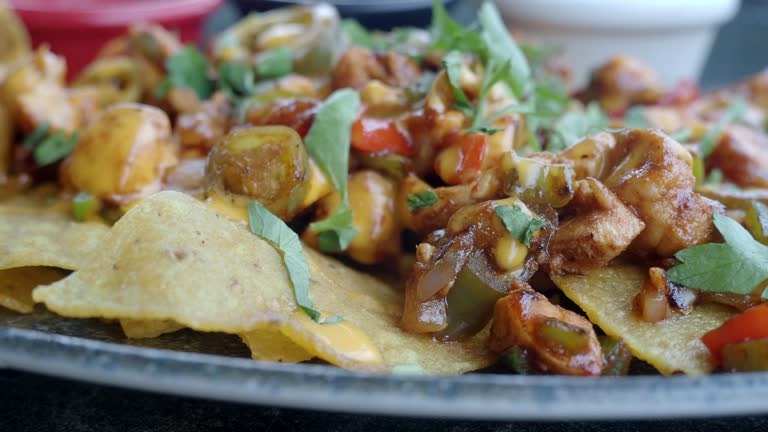
Texas chili shines solo but elevates with thoughtful pairings that cut the richness or amp the fun. Cornbread soaks up the gravy, while cold beers tame the spice—think local craft IPAs or classic Lone Star. Toppings like shredded cheddar, diced onions, or jalapeños add crunch and personalization.
At my last potluck, I set out a toppings bar; guests customized like artists, turning dinner into a party. It’s these touches that make sharing special.
Classic Sides for Balance
- Cornbread or tortillas: For scooping and sopping.
- Coleslaw: Creamy coolness against the heat.
- Rice: Stretches servings, Tex-Mex style.
Avoid heavy starches; keep it light to let chili lead.
Drinks to Quench the Fire
Beer reigns supreme—pale ales for hoppy contrast, stouts for malt depth. Non-alcoholic? Iced tea or horchata smooths the edges.
Humorously, milk works in emergencies, but real Texans tough it out with agua fresca.
Toppings Table for Customization
| Topping | Texture/Flavor Added | Why It Works |
|---|---|---|
| Shredded Cheddar | Melty, tangy | Cuts spice with creaminess |
| Diced Red Onion | Crunchy, sharp | Freshens each bite |
| Sour Cream | Cool, velvety | Balances heat |
| Cilantro | Herbal, bright | Adds Mexican flair |
| Fritos | Crispy, salty | Turns it into pie |
Health Benefits and Nutritional Breakdown of Texas Chili
Beyond comfort, Texas chili packs protein from beef for muscle repair and antioxidants from chiles that fight inflammation. It’s naturally low-carb without beans, supporting steady energy, though moderation tempers the sodium. Spices like cumin aid digestion, making it a smart cold-weather choice.
As someone who’s relied on it post-workout, the iron boost keeps me going. Just watch portions—it’s hearty!
Key Nutrients Per Serving (About 1 Cup, Based on 4-lb Beef Recipe)
Using standard calculations for a no-bean version:
| Nutrient | Amount per Serving | % Daily Value* | Benefit |
|---|---|---|---|
| Calories | 300-350 | 15-18% | Sustained energy |
| Protein | 25-30g | 50-60% | Muscle building |
| Fat | 15-20g | 20-25% | Healthy satiety |
| Carbs | 10-15g | 4-5% | Low for keto-friendly |
| Iron | 3-4mg | 15-20% | Boosts oxygen transport |
| Vitamin C | 20-30mg | 25-35% | Immune support from chiles |
*Based on 2,000-calorie diet; varies by exact ingredients. Leaner cuts lower fat; add veggies for fiber.
Potential Drawbacks and Healthier Twists
High sodium from broth can spike blood pressure—use low-sodium versions. For heart health, trim visible fat and pair with greens.
Twists: Turkey substitution cuts calories by 30%; vegetarian with mushrooms mimics texture, though not traditional.
Common Mistakes to Avoid When Making Texas Chili
Newbies often rush the simmer or skimp on fresh chiles, ending up with flat, soupy results instead of thick, flavorful gold. Over-spicing early can bitter up, while ignoring the pot’s heat leads to scorched bottoms. Patience is your best friend here.
I learned the hard way with a too-hasty batch—tasted like spicy beef soup. Now, I preach slow and steady every time.
Top Pitfalls and How to Dodge Them
- Not Browning Meat Properly: Skips flavor-building Maillard reaction. Fix: Sear in batches over medium-high.
- Using Stale Spices or Powder Only: Mutes complexity. Fix: Toast whole spices; make fresh chile paste.
- Adding Acid Too Late: Vinegar or lime brightens end notes. Fix: Stir in last 30 minutes.
- Overcooking Veggies: Turns them mushy. Fix: Sauté briefly before simmering.
From experts, skipping acidity is huge—chili needs that pop.
Pros and Cons of Common Substitutions
| Substitution | Pros | Cons |
|---|---|---|
| Ground Beef | Quick cook time | Less tender texture |
| Canned Chiles | Convenient | Lacks depth, too watery |
| Tomato Paste | Adds body (non-traditional) | Can overpower chiles |
| Beer for Broth | Malt richness | Alcohol may not cook off fully |
People Also Ask: Answering Top Questions on Texas Chili
Google users often wonder about the nuances of this beloved dish. Here, we tackle real search queries with straightforward insights, optimized for quick answers.
What Is Texas Chili Made Of?
Texas chili is primarily beef (like chuck roast), dried chiles (ancho, guajillo), onions, garlic, and spices such as cumin and oregano. No beans or tomatoes in the purest form—just a rich, red chile gravy coating tender meat. It’s simple yet profound, clocking in at about 300 calories per serving with high protein.
Why Is There No Beans in Texas Chili?
Beans are omitted to honor frontier traditions where they were fillers, not stars—cowboys wanted meat-focused sustenance. Authentic recipes emphasize beef and chiles for bold flavor; adding beans shifts it to a different style. Texans debate it fiercely, but no-bean wins for purists.
What Is the Difference Between Texas Chili and Regular Chili?
Texas chili skips beans and relies on chile paste over powder, using cubed beef for texture versus ground in many “regular” versions. It’s spicier and simpler, without fillers like corn or veggies common elsewhere. Think pure heat vs. hearty mix.
Where Did Texas Chili Come From?
It originated in 19th-century Texas from Mexican carne con chile, popularized by San Antonio’s Chili Queens in the 1860s. Evolving on cattle drives, it became the state dish in 1977. Roots trace to Aztec stews, but Texas made it iconic.
How Spicy Is Texas Chili?
Authentic versions range from mild (using mostly anchos) to fiery (with arbols and serranos), hitting 2,000-10,000 Scoville units. Adjust chiles for tolerance—start low if you’re heat-shy. It’s bold but balanced, not overwhelming.
FAQ: Your Burning Questions on Texas Chili Answered
Got queries? These cover common curiosities from home cooks and curious eaters.
Q: Can I make Texas chili in an Instant Pot?
A: Yes! Brown meat on sauté, add everything, then pressure cook for 45 minutes with natural release. It saves time but watch for less evaporation—thicken post-cook.
Q: Is Texas chili gluten-free?
A: Absolutely, if you skip beer (use broth) and ensure masa harina is certified GF. Traditional recipes are naturally free of wheat.
Q: How long does homemade Texas chili last?
A: Refrigerate for 4-5 days or freeze up to 3 months. Reheat gently to preserve texture—it’s often better the next day.
Q: What’s the best beer for Texas chili?
A: A malty amber or stout like Shiner Bock adds depth without overpowering. Skip light lagers; they dilute the richness.
Q: Can kids eat Texas chili?
A: Tone down heat by reducing arbols and adding cheese or sour cream. The beefy base appeals, but test mild versions first.
Wrapping Up the Texas Chili Journey
From the sun-baked trails of yesteryear to your modern kitchen, Texas chili captures the unyielding spirit of the state—fierce, flavorful, and full of heart. Whether you’re simmering a pot for game day or seeking spots to savor it, this dish invites you into a legacy that’s as enduring as the Texas sky. Next time you ladle out a bowl, raise it to the chili queens and cowboys who started it all. Who’s ready to cook?
